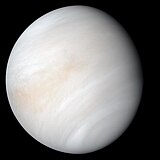Datei:PIA23791-Venus-RealAndEnhancedContrastViews-20200608 (cropped).jpg
Erscheinungsbild

Gress dea Voaschau: 600 × 600 Pixel Weitere Auflésungan: 240 × 240 Pixel | 480 × 480 Pixel | 768 × 768 Pixel | 1.096 × 1.096 Pixel.
Version in hechara Auflesung (1.096 × 1.096 Pixel, Dateigress: 30 KB, MIME-Typ: image/jpeg)
Dateiversiona
Wensd auf an Zeitpunkt klickst, nacha konst a friaane Version lodn.
| Version vom | Vorschaubuidl | Dimensióna | Nutzer | Kommentar | |
|---|---|---|---|---|---|
| aktuell | 00:40, 10. Jul. 2020 |  | 1.096 × 1.096 (30 KB) | PhilipTerryGraham | File:PIA23791-Venus-RealAndEnhancedContrastViews-20200608.jpg cropped 51 % horizontally using CropTool with precise mode. |
Dateivawendung
Seitn wo de Datei nutzn:
Globale Dateinutzung
D'noochéfóiganden åndern Wikis vawénden dé Datei:
- Vawendung af ary.wikipedia.org
- Vawendung af arz.wikipedia.org
- Vawendung af ast.wikipedia.org
- Vawendung af as.wikipedia.org
- Vawendung af awa.wikipedia.org
- Vawendung af azb.wikipedia.org
- Vawendung af az.wikipedia.org
- Vawendung af ban.wikipedia.org
- Vawendung af bat-smg.wikipedia.org
- Vawendung af ba.wikipedia.org
- Vawendung af bcl.wikipedia.org
- Vawendung af be-tarask.wikipedia.org
- Vawendung af be.wikipedia.org
- Vawendung af bew.wikipedia.org
- Vawendung af bg.wikipedia.org
- Vawendung af bh.wikipedia.org
- Vawendung af bjn.wikipedia.org
- Vawendung af bn.wikipedia.org
- Vawendung af bo.wikipedia.org
- Vawendung af br.wikipedia.org
- Vawendung af bs.wikipedia.org
- Vawendung af btm.wikipedia.org
- Vawendung af bxr.wikipedia.org
- Vawendung af ca.wikipedia.org
- Vawendung af cdo.wikipedia.org
- Vawendung af ceb.wikipedia.org
- Vawendung af ce.wikipedia.org
- Vawendung af chr.wikipedia.org
- Vawendung af ckb.wikipedia.org
- Vawendung af co.wikipedia.org
- Vawendung af crh.wikipedia.org
- Vawendung af cr.wikipedia.org
- Vawendung af csb.wikipedia.org
- Vawendung af cs.wikipedia.org
- Vawendung af cu.wikipedia.org
- Vawendung af cv.wikipedia.org
- Vawendung af cy.wikipedia.org
- Vawendung af dag.wikipedia.org
- Vawendung af da.wikipedia.org
- Vawendung af de.wikipedia.org
- Vawendung af dga.wikipedia.org
- Vawendung af din.wikipedia.org
- Vawendung af diq.wikipedia.org
- Vawendung af dsb.wikipedia.org
- Vawendung af dty.wikipedia.org
- Vawendung af el.wikipedia.org
- Vawendung af eml.wikipedia.org
Weitere globale Verwendungen dieser Datei anschauen.




